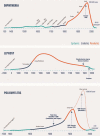Epidemics and outbreaks of peripheral nervous system disorders: I. infectious and immune-mediated causes
- PMID: 32914207
- PMCID: PMC7483039
- DOI: 10.1007/s00415-020-10215-9
Epidemics and outbreaks of peripheral nervous system disorders: I. infectious and immune-mediated causes
Erratum in
-
Correction to: Epidemics and outbreaks of peripheral nervous system disorders: I. infectious and immune-mediated causes.J Neurol. 2021 Mar;268(3):891. doi: 10.1007/s00415-020-10280-0. J Neurol. 2021. PMID: 33399969 Free PMC article. No abstract available.
Abstract
The history of mankind is marked by numerous epidemics, some of which involved diseases of the peripheral nervous system, either infectious or otherwise. We describe here the three main infectious causes of epidemics that affect the peripheral nervous system: leprosy, poliomyelitis and diphtheria. We then discuss the main epidemics of immune-mediated origin.
Keywords: Diphtheria; Guillain–Barré syndrome; HIV; Leprosy; Lyme; Poliomyelitis.
Conflict of interest statement
The authors report no disclosures relevant to the manuscript.
Figures




Similar articles
-
Epidemics and outbreaks of peripheral nervous system disorders: II. Toxic and nutritional causes.J Neurol. 2021 Mar;268(3):892-902. doi: 10.1007/s00415-020-10216-8. Epub 2020 Sep 11. J Neurol. 2021. PMID: 32915310 Free PMC article.
-
Infectious neuropathies.Neurol Clin. 2007 Feb;25(1):115-37. doi: 10.1016/j.ncl.2006.11.004. Neurol Clin. 2007. PMID: 17324723 Review.
-
Pattern, causes and functional outcome of peripheral neuropathies in the Amazon region.PLoS One. 2024 Dec 20;19(12):e0315760. doi: 10.1371/journal.pone.0315760. eCollection 2024. PLoS One. 2024. PMID: 39705222 Free PMC article.
-
[Lower urinary tract dysfunction and peripheral neuropathies: the model of Guillain-Barré syndrome].Prog Urol. 2007 May;17(3):379-80. doi: 10.1016/s1166-7087(07)92333-7. Prog Urol. 2007. PMID: 17622062 French.
-
Ocular neuropathy in peripheral neuropathies.Muscle Nerve. 2012 Nov;46(5):681-6. doi: 10.1002/mus.23414. Muscle Nerve. 2012. PMID: 23055310 Review.
References
-
- Maymone MBC, Laughter M, Venkatesh S, et al. Leprosy: clinical aspects and diagnostic techniques. J Am Acad Dermatol. 2020;83:1–14. - PubMed
-
- Gibert CM. Remarques historiques et critiques sur la lèpre. Rev Med Franc Etrang. 1840;3:19–44.
-
- Byrne JP. Encyclopedia of pestilence, pandemics, and plagues. Westport: Greenwood Publishing Group; 2008.
MeSH terms
LinkOut - more resources
Full Text Sources
Medical

